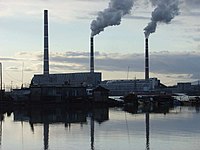
Photo from wikipedia
Abstract In China, climate policy has been strengthened by the mandated carbon intensity reduction target, which is a simple measurement of carbon efficiency under the single-factor framework. Is this carbon… Click to show full abstract
Abstract In China, climate policy has been strengthened by the mandated carbon intensity reduction target, which is a simple measurement of carbon efficiency under the single-factor framework. Is this carbon regulation during the 12th Five-Year Plan (FYP) actually effective for total factor carbon efficiency (TFCE) in China? To answer this research question, we estimate the TFCE and its policy and economic drivers using the fixed-effect stochastic frontier approach. The main results are as follows. First, the TFCE shows time and sector heterogeneity ranging from 0.235 to 0.996. Moreover, the changing pattern implies a positive relationship between TFCE and the 12th FYP. Second, the implementation of carbon regulations during the 12th FYP not only helped meet the carbon intensity reduction target, but also assisted in effectively improving TFCE. Third, carbon regulations have positively enhanced the role of energy prices in TFCE promotion and alleviated the negative role of exports. The results have significant policy implications for the carbon regulations in China's forthcoming 14th FYP. It is necessary to introduce market-oriented tools aside from the existing command-and-control policies.
Journal Title: Technological Forecasting and Social Change
Year Published: 2020
Link to full text (if available)
Share on Social Media: Sign Up to like & get
recommendations!